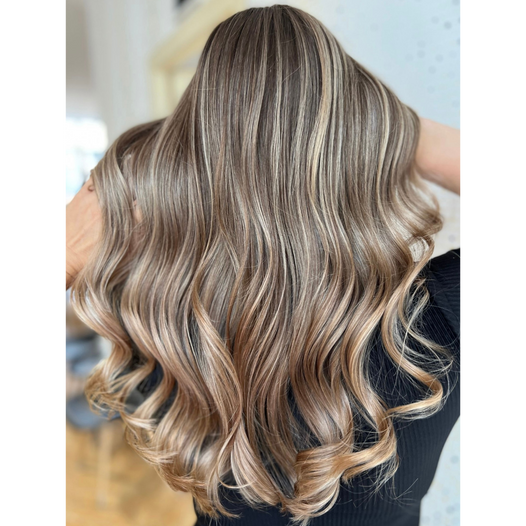
How to Care for an Oily Scalp with Coily and Curly Hair

Caring for an oily scalp when you have coily or curly hair can be challenging, as the natural texture of your hair may not allow for frequent washing, which can strip your strands of necessary moisture. Managing an oily scalp while maintaining the health of your curls involves balancing sebum production, choosing the right products, and using techniques that keep both your scalp and hair in optimal condition.
Understanding an Oily Scalp
An oily scalp occurs when the sebaceous glands in the scalp produce excess sebum, the natural oil that keeps your scalp and hair moisturized. While sebum is essential for healthy hair, too much of it can lead to greasy roots, dandruff, and even hair thinning.
Common Causes: Overactive Sebaceous Glands: Genetic predisposition can cause your glands to produce more oil than necessary.
Hormonal Changes: Hormonal fluctuations, such as those during puberty or pregnancy, can increase sebum production.
Improper Hair Care: Over-washing, using heavy products, or not cleansing the scalp thoroughly can contribute to oiliness.
Diet: A diet high in greasy or processed foods can exacerbate oil production.
Effective Strategies for Managing an Oily Scalp
1. Use the Right Shampoo
Clarifying Shampoos: Use a clarifying shampoo once a week to remove excess oil, product buildup, and impurities from your scalp.
Sulfate-Free Shampoos: On other days, opt for a gentle, sulfate-free shampoo that cleanses without stripping your scalp or drying out your curls.
Recommended Products:
Neutrogena Anti-Residue Shampoo
DevaCurl Buildup Buster
2. Wash Your Hair Regularly, but Not Too Often
Balanced Washing Schedule: While it might be tempting to wash your hair frequently, aim for washing 1-2 times per week. Washing too often can lead to overproduction of oil as your scalp tries to compensate for the loss of natural oils.
Focus on the Scalp: When washing, concentrate the shampoo on your scalp rather than your hair lengths to avoid drying out your curls.
3. Condition Wisely
Lightweight Conditioners: Use a lightweight, oil-free conditioner on your hair lengths and ends. Avoid applying conditioner directly to your scalp, as it can add to the oiliness.
Rinse Thoroughly: Make sure to rinse your hair thoroughly to remove all traces of conditioner, which can contribute to build-up and greasiness.
Recommended Products:
Ouidad Curl Quencher Moisturizing Conditioner
SheaMoisture Daily Hydration Conditioner
4. Avoid Heavy, Oily Products
Lightweight Styling Products: Choose lightweight gels, mousses, or creams that won’t weigh down your curls or add extra oil to your scalp.
Non-Comedogenic Oils: If you use oils, opt for non-comedogenic (non-pore clogging) oils like argan or grapeseed oil, and apply them sparingly to your hair ends.
5. Incorporate Scalp Treatments
Scalp Scrubs: Exfoliate your scalp once a week with a gentle scalp scrub to remove excess oil and dead skin cells, which can clog pores and lead to further oil production.
Tea Tree Oil: Add a few drops of tea tree oil to your shampoo or use a scalp treatment that contains tea tree oil, which has natural antiseptic and oil-controlling properties.
Recommended Products:
Briogeo Scalp Revival Charcoal + Coconut Oil Micro-Exfoliating Shampoo
Paul Mitchell Tea Tree Special Shampoo
6. Dry Shampoo as a Quick Fix
Absorb Excess Oil: Use dry shampoo between washes to absorb excess oil and refresh your roots. Look for a product that doesn’t leave a white residue, which can be more noticeable on curly or coily hair.
Apply Sparingly: Focus on the roots and use just enough to soak up oil without making your scalp dry or itchy.
Recommended Products:
Batiste Dry Shampoo
Not Your Mother’s Clean Freak Refreshing Dry Shampoo
7. Opt for Protective Styles
Low-Maintenance Styles: Styles like braids, twists, or buns can help manage an oily scalp by reducing the need for frequent manipulation and washing.
Avoid Tight Styles: Ensure that your protective styles aren’t too tight, as this can lead to scalp irritation and increase oil production as your scalp tries to protect itself.
8. Rethink Your Diet
Healthy Eating: Maintain a diet rich in fruits, vegetables, and healthy fats to support balanced sebum production. Limit greasy, processed foods that can contribute to oily skin and scalp.
Stay Hydrated: Drink plenty of water to keep your scalp hydrated and help regulate oil production.
9. Avoid Over-Touching Your Hair
Hands Off: Try not to touch your hair or scalp frequently, as the oils and dirt from your hands can transfer to your scalp, making it oilier.
10. Use a Satin or Silk Pillowcase
Prevent Oil Transfer: Sleep on a satin or silk pillowcase to reduce friction and prevent oil from transferring to your hair, which can exacerbate greasiness.
Hair Care Routine for an Oily Scalp
- Pre-Shampoo Treatment: Apply a lightweight scalp treatment with tea tree oil or a clarifying treatment to help control oil production.
- Shampoo: Use a sulfate-free shampoo 1-2 times a week, focusing on cleansing the scalp thoroughly.
- Conditioning: Apply a lightweight conditioner only to your hair lengths and ends, avoiding the scalp. Rinse thoroughly.
- Styling: Use lightweight styling products to define curls without adding heaviness or oil. Apply sparingly.
- Between Washes: Use dry shampoo to absorb excess oil at the roots and refresh your hair.
- Weekly Treatment: Exfoliate your scalp with a gentle scrub to remove buildup and excess oil.
Caring for an oily scalp with coily and curly hair requires a careful balance between cleansing and moisturizing. By choosing the right products, washing at appropriate intervals, and incorporating specific treatments, you can manage oiliness while keeping your curls healthy and vibrant. With these strategies, you can achieve a balanced scalp and maintain beautiful, well-defined curls.









Leave a comment